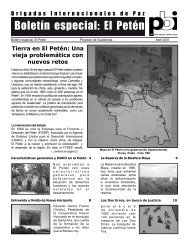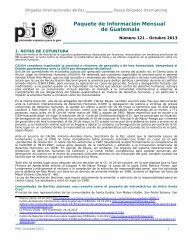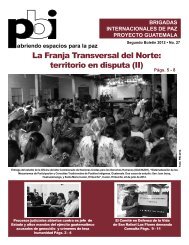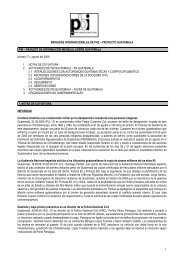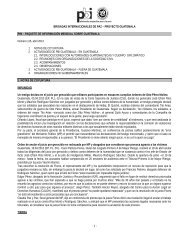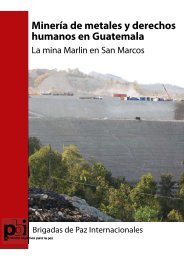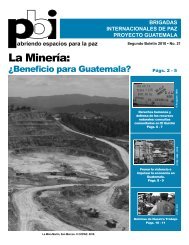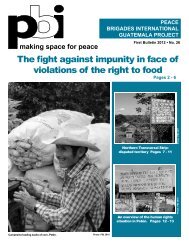The Northern Transversal Strip disputed territory (II) Photo
Bulletin 27 - 2nd of 2012 (pdf 1.4 MB) - PBI
Bulletin 27 - 2nd of 2012 (pdf 1.4 MB) - PBI
Create successful ePaper yourself
Turn your PDF publications into a flip-book with our unique Google optimized e-Paper software.
PEACE BRIGADES INTERNATIONAL<br />
Brigadas Internacionales de Paz<br />
quetzals (Q) from European and US banks, including the Inter-<br />
American Development Bank (IDB) and the World Bank (WB) 5<br />
for the construction of the Chulac dam in Alta Verapaz 6 . <strong>The</strong>y<br />
invested 5 million dollars (US$) in the Usumacinta river project<br />
and secured external funding for the Xalalá hydroelectric plant<br />
in Ixcán, Quiché 7 ; the aim was to be in a position to export electrical<br />
energy from 1983 8 .<br />
In 1986, during the Vinicio Cerezo government, the commercial<br />
operations of the large hydroelectric plant Río Negro or<br />
Chixoy began, more than 10 years after the project commenced.<br />
<strong>The</strong> process had started during the government of Coronel<br />
Arana Osorio (1970-1974), and the process of filling the reservoir<br />
was finished in 1983, under the General Mejía Víctores 9 . In<br />
the Report into the identification and verification of damage and<br />
injustices caused to the communities affected by the construction<br />
of the Chixoy hydroelectric plant, details of grave human<br />
rights violations were documented. It also outlined the responsibility<br />
of the State, particularly the INDE, in the serious consequences<br />
of the construction of Chixoy for the communities and<br />
their population. In its conclusions it is stated that ‘a consensus<br />
has been reached between parties which recognises that forced<br />
displacement of these communities was used by the State<br />
of Guatemala to carry out said construction” 10 .<br />
<strong>The</strong> lessons of what happened to the communities affected<br />
by the installation of the large dam on Chixoy constitute a<br />
starting point of how to approach the planning and execution<br />
of future hydroelectric projects in the region. More recently the<br />
report about the Situation and Threats to Natural Resources of<br />
the FTN published by the Guillermo Toriello Foundation (FGT),<br />
concluded that the electricity supply network that the Government<br />
is planning, constitutes new evidence that the outcome of<br />
the hydroelectric projects is directed towards “providing energy<br />
to industrial centres and to exportation, not necessarily to bring<br />
power to the rural communities in the area” 11 .<br />
“In the north of Quiché, where two large hydroelectric projects<br />
already operate (Palo Viejo and HidroXacbal) and<br />
three more are in the consideration phase, only 10 communities<br />
have access to electricity, according to SEGEPLAN.<br />
(…) <strong>The</strong> hydroelectric companies are defending themselves<br />
saying that they do not distribute electricity. This job<br />
falls to the State. That is certain. But the paradox continues<br />
without a solution” 12 .<br />
In January 2011, in the north of the departments of Quiché<br />
and Huehuetenango alone at least 13 hydroelectric projects<br />
were being planned. As a result a community initiative has been<br />
set up that searches and systematises information relating to<br />
land issues and exploitation of natural resources. According<br />
to one of their popular bulletins “the majority of the medium<br />
and large hydroelectric plant being constructed in the north of<br />
Quiché will be part of the project entitled the Expansion of the<br />
Guatemalan Interconnected Electrical Energy Transportation<br />
System (2008-2018) managed by the National Commission of<br />
Electrical Energy (CNEE) that aims to connect the whole country<br />
via electrical cables divided into six grids. It also aims to connect<br />
up with Mexico and El Salvador. According to information<br />
provided by the Government and Invest Guatemala, Quiché will<br />
be part of the Hydro grid that also includes Alta Verapaz, Baja<br />
Verapaz and Huehuetenango with a total of 464.3 km in cables<br />
passing through eight substations and will cost a predicted US$<br />
108.7 million” 13 .<br />
“… without having been consulted or informed, mining and<br />
hydroelectric exploration and exploitation projects already<br />
exist and are being developed on our lands, our waters and<br />
our populations, that directly threaten the life and future of<br />
5 Kading, T.W., ‘<strong>The</strong> Guatemalan military and the economics of <strong>The</strong> Violence’, Canadian Journal of Latin American & Caribbean Studies, March 1999. <strong>The</strong> project planned by the INDE –<br />
but not completely funded by (to February 2012)-, this was designed to generate between 440 and 340 MW.<br />
6 Prensa Libre, ‘Government manages credit for Q850 millions, Q750 millions for the Chulac hydroelectric and Q100 million for a new port’, Guatemala, 08.04.1980; Prensa Libre, ‘’ <strong>The</strong><br />
Chulac hydroelectric plant is declared national emergency’, Guatemala, 16.04.1980.<br />
7 Kading, T.W., Op. Cit. In 2010, a report from various European social networks and a popular version concluded: “<strong>The</strong> Xalalá project is a large project that will cause significant social,<br />
economic and environmental changes that will affect communities of the region. As a result it has generated social rejection, tension and concern amongst communities over access to<br />
sources of subsistence and natural resources, such as land and water, the environment. This will affect their health and their traditional ways of life at home and within the communities.<br />
For much of them displacement, expropriation and relocation is predicted”. CIDSE, CIFCA, FIAN International, Grupo Sur and Action Aid, ‘Project Xalalá, Development for everyone?’<br />
Guatemala, June 2009.<br />
8 Prensa Libre, ‘Guatemala will export electricity by 1983’, Guatemala, 27.12.1975.<br />
9 Dialogue between the Government of the Republic of Guatemala and the Coordinator of Communities Affected by the Construction of Chixoy Hydroelectric (COCAHICH), ‘Report of<br />
identification and verification of damage and injustices caused to communities affected by the construction of the Chixoy Hydroelectric, Equipo Nizkor, 09.11.2009 http://www.derechos.<br />
org/nizkor/guatemala/doc/chixoy12.html#n1<br />
<strong>The</strong> Chixoy hydroelectric project, the biggest in the country with a capacity of 300MW, is located in the departments of Quiché and Baja and Alta Verapaz on the Chixoy River. <strong>The</strong> flood<br />
ing needed to install the reservoir spanned an area of 50 km and 50 meters deep. Its construction began in April 1977 and was finished on 27 November 1983, formally starting to be<br />
used in December 1985. <strong>The</strong> lifespan of the reservoir is estimated to be 50 years.<br />
10 Ibidem.<br />
11 FGT, ‘Situation and Threats on Natural Resources of the <strong>Northern</strong> <strong>Transversal</strong> <strong>Strip</strong>’, Guatemala, September, 2011.<br />
12 Escalón, S., ‘Hydroelectric plants: Getting to the bottom of their contradictions (I)’, Plaza Pública, 29.06.2012.<br />
13 Resistance of the people, cit., January 2011<br />
6 Second Bulletin 2012 • No. 27



